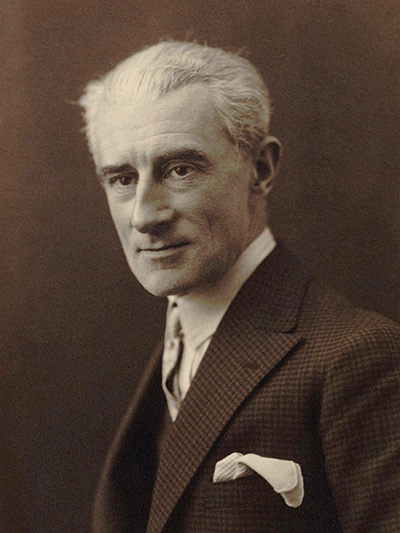Maurice Ravel

- Born: March 7, 1875, Ciboure, Basses-Pyrénées, France
- Died: December 28, 1937, Paris, France
Rapsodie espagnole
- Composed: 1907-08
- Premiere: March 15, 1908 in Paris, conducted by Édouard Colonne.
- Instrumentation: 2 flutes, 2 piccolos, 2 oboes, English horn, 2 clarinets, bass clarinet, 3 bassoons, sarrousophone, 4 horns, 3 trumpets, 3 trombones, tuba, timpani, bass drum, castanets, crash cymbals, snare drum, suspended cymbals, tam-tam, tambour de Basque, triangle, xylophone, 2 harps, celeste, strings
- CSO notable performances: First Performance: October 1926, Fritz Reiner conducting. Most Recent: September 2012, William Eddins conducting. Other: Jesús López Cobos and the CSO recorded the work on the 1988 Ravel: Boléro, Rapsodie espagnole, et al. CD.
- Duration: approx. 16 minutes
“Ravel’s Spain was an ideal Spain inherited from his mother, a lady who used to delight me with her conversation, always in fluent Spanish, about the youthful years she had spent in Madrid. Then I could understand with what fascination her son must have heard the frequent retelling of these reminiscences, the songs and the dances associated with them. And that also explains not only the attraction Ravel felt for this country of his childhood dreams, but also why he had such a strong preference for the rhythm of the Habanera—the song form that was most in vogue during his mother’s day in Madrid.” Manuel de Falla, Spain’s greatest composer, wrote those words about his French colleague to explain the persistent Spanish strain in Ravel’s music. Not only this Spanish Rhapsody but also Boléro, Alborada del gracioso and L’heure espagnole attest to the Hispanic interests fostered by his mother’s stories and his Basque birthplace on the slopes of the Pyrenees.
In the years immediately following his failure to win the Prix de Rome in 1905, Ravel enjoyed a burst of creativity fueled by his freedom from academic restraints for the first time in his life. In the late summer of 1907, when he first took up the Rapsodie espagnole, he was bothered by the street noises bombarding his apartment in Paris, and some friends offered him the use of their yacht moored at Valvins. He gladly accepted, and soon took up the life of a recluse, seeing no one except the boat’s gruff but likable captain, with whom he shared his meals. Ravel worked quickly, and he was soon able to return to Paris with the finished score.
By 1908, when the Rapsodie espagnole was launched into the world, Ravel’s name was one of the most widely known in French music. The occasion of the premiere added yet another bit of notoriety to his reputation, since the audience received Ravel’s new work with a mixed reaction. The galleries, which held many of Ravel’s supporters, enthusiastically acclaimed the piece, but a certain murmuring rose from the lower levels of the Théâtre du Châtelet, where the more staid members of the audience congregated. Above the rustling, Florent Schmitt, Ravel’s close friend and fellow composer, called out, “Just once more, for the gentlemen below who haven’t been able to understand.” The Malagueña section was encored by the sympathetic performers, and, despite some critical carping, the work became a success.
Rather than a single span of music, the Rapsodie espagnole is really a miniature suite of three dances with a prelude. Ravel described the first section of the Rapsodie, Prélude à la nuit (“Prelude to the Night”), as “voluptuously drowsy and ecstatic.” The Malagueña was based on a genre that was initially a Spanish courting dance that had developed into a virtuoso vehicle for the café singers of the 19th century. The Habanera, whose rhythm is similar to that of the tango, is an orchestration of Ravel’s piano piece of 1895, subtitled in both versions Au pays parfumé que le soleil caresse (“In the fragrant land caressed by the sun”). The Feria (“Festival”) is an exhilarating depiction of an Iberian holiday.
—Dr. Richard E. Rodda